Review for Star Trek - Deep Space Nine - Series 6 (Slimline Edition)
Introduction
When Gene Roddenberry was developing The Next Generation of Star Trek, one of his aims was to not rely on dramatic conflict between the human characters, with the idea that humanity had ‘evolved’ past petty bickering in the 24th Century, relying instead on the allegory of alien bickering to shine a light on our own 20th Century shortcomings. It’s telling that Deep Space Nine debuted after Roddenberry’s death in 1991, as it’s all about conflict. Interesting drama comes from interpersonal conflict, and with the Federation rubbing up against the Cardassians and the Bajorans, and later on the Maquis, the Klingons and the Dominion, there was plenty of conflict to be had. Season 6 of Deep Space Nine goes the whole hog, and gives us a full blown, intergalactic war. So much for evolved humanity!
At the edge of the final frontier there’s... politics. The planet Bajor has finally been returned to its population after decades of occupation, oppression, and exploitation by the Cardassian Empire. The wrecked world needs help getting back on its feet, and the provisional government has called in the Federation and Starfleet to administer the space station the Cardassians left behind, now dubbed Deep Space Nine, in the hope that it will become a hub for trade and commerce in the sector. To that end, and to move the Bajorans toward eventual Federation membership, Captain Benjamin Sisko has been assigned to DS9, while the Bajorans has assigned Major Kira Nerys of Bajoran militia as his second in command. But the discovery of a stable wormhole in the nearby Denorius Belt, offering a shortcut to the Gamma Quadrant, turns a galactic backwater into the strategic centre of the galaxy. What starts off as a gateway to exploration turns a lot more sinister when they encounter the dominant power in the Gamma Quadrant, the Dominion led by the shapeshifting Founders, Changelings who can only see the Federation, and all other ‘solids’ as a threat.
At the end of season 5, tensions came to a head following Cardassia joining the Dominion. The mining of the entrance of the wormhole to stop the flow of Dominion reinforcements to Cardassia provoked a response when the combined Jem’Hadar and Cardassian fleet attacked. Bajor signed a non-aggression treaty with the Dominion, and the Federation withdrew from the station, leaving a few stragglers behind, including reporter Jake Sisko. The last we saw, the Defiant had joined a massive Federation fleet, on its way to repel the Dominion takeover. That was three months previously. 26 episodes of Deep Space Nine are presented across 7 discs.
Disc 1
1. A Time to Stand
2. Rocks and Shoals
3. Sons and Daughters
4. Behind the Lines
Disc 2
5. Favor the Bold
6. Sacrifice of Angels
The fleet is battered, beaten, and significantly reduced at the start of the opening six episode arc. Three months have passed since the start of the war, three months in which the Federation has consistently been on the losing side. So it’s something of a desperate move when a mission is ordered across enemy lines in a stolen Jem’Hadar ship to attack the sole Ketracel White facility in the Alpha Quadrant; Ketracel White being the drug that the Founders use to keep the Jem’Hadar obedient. Meanwhile on the captured DS9, or Terok Nor, Gul Dukat is in charge of rectifying that deficiency by taking down the minefield blockading the wormhole. It isn’t going exactly to plan. Kira has to contain her disgust as she works with the new ‘allies’ of Bajor, especially Dukat, a position she find increasingly difficult. Trying to make life easier for the Bajorans by getting Odo on the station’s ruling council backfires when Odo encounters the female changeling, a distraction that Kira and Odo’s fledgling resistance cell doesn’t need. It’s a distraction that could prove fatal when Rom is caught trying to sabotage the station’s deflector array. For time runs out when the Cardassians finally discover how to take down the minefield, and it becomes imperative for the Federation to retake the station. But there are prices that must be paid, both by Sisko, and Gul Dukat.
Note: Sons and Daughters has a BBFC mandated cut of 25 seconds. This was to a Klingon family blood ritual, an imitable technique in the waning years of the HIV/AIDS panic. It’s a scene where three Klingons share a dagger to shed some blood into a bowl. The PAL release version cuts the scene so that only General Martok is seen cutting his hand and letting the blood drip. It then jumps to the conclusion of the scene.
7. You Are Cordially Invited
Deep Space Nine may have been liberated, the Dominion and Cardassian forces repulsed from Bajor, but the war still rages on. That hasn’t stopped the resident population of DS9 celebrating for the past week. The celebrations are about to get a lot more raucous, and Dax and Worf’s wedding is at hand. But first, Worf and his closest friends must go through one of those Klingon rituals (absolutely not a bachelor party), while Dax has to impress General Martok’s wife Sirella, if she is to marry into the House of Martok.
8. Resurrection
Newlyweds Dax and Worf have invited Kira over for dinner to share their wedded bliss, but the question arises as to who Kira should bring as a date. Certainly not Captain Boday, he of the transparent skull, and it’s too soon to even think about Odo. So what about Bareil? You’d think the fact that he’s dead would be an impediment, but Bareil Antos has just arrived on the station, a refugee from the mirror universe. Kira’s first impression of the thief and scoundrel isn’t positive, but there is something compelling about him, and it’s not just his resemblance to the late Vedek.
Disc 3
9. Statistical Probabilities
Julian Bashir was lucky when his genetically engineered status was discovered. He got to stay in Starfleet while his parents paid the price for their crime. Others aren’t so lucky, they get institutionalised in childhood, prevented from contributing to society for their unfair advantage, and not all genetic engineering is as successful as it was for Bashir. Four such individuals are being brought to Deep Space Nine to meet Bashir, as an example of someone who can fit in, can still contribute. Jack, Patrick, Lauren and Sarina may not exactly fit in, but it’s when they find a meaningful vocation, that the trouble begins.
10. The Magnificent Ferengi
When last we saw Quark’s mother Ishka, she had quietly become the power behind the Ferengi throne, only now it turns out that she’s been captured by the Dominion. When Quark gets a communication from the Grand Nagus, he sees a chance for the Ferengi to be heroic for a change, fed up with having his limelight stolen by Starfleet exploits. He puts together a crack team of Ferengi to go behind enemy lines on a daring commando raid. The only trouble is that Ferengi don’t make for very good action heroes.
11. Waltz
It’s time for Dukat to face justice, or at least the start of justice. He’s been declared mentally fit for trial following his breakdown at the death of his daughter Ziyal, and Sisko is escorting him on the Honshu to his arraignment hearing. Only the ship comes under Cardassian attack and is destroyed. Dukat manages to drag Sisko to a shuttle and they make it to a barren planet, but Sisko is injured, leaving Dukat to keep them both alive in the hope that the shuttle’s distress call will be heard. Only Dukat isn’t quite as cured as his doctors had claimed...
12. Who Mourns for Morn?
Barfly, and Quark’s favourite customer Morn is dead! Of course he only became Quark’s favourite customer once his will was read, and it turned out that he left everything to Quark. Everything including his debts, some cheesy art, and some rotting cargo. And when it turns out that he had also won 1000 bricks of gold pressed latinum, the ex-wife and the business associates come crawling out of the woodwork too.
Disc 4
13. Far Beyond The Stars
The war isn’t going well, and the loss of another friend pushes Sisko into thoughts of resigning from Starfleet. Indeed the stress gets too much and he starts seeing visions of people in historical dress... Benny Russell is an aspiring science fiction writer, who’s got a steady-ish job for Incredible Tales magazine. One particular fantasy image inspires him to write a story about the distant future, about a space station commanded by a black man. The only problem is that he’s a black writer, trying to sell this story in 1950’s New York. And as the stress mounts, he starts seeing visions of the characters in his story...
14. One Little Ship
The Defiant crew get a break from the war when they are assigned a mission to investigate a subspace compression anomaly. It has the odd effect of shrinking any probe sent into it. Only no-one told the Jem’Hadar about this study. They attack when Dax, O’Brien and Bashir are in a runabout inside the anomaly. They disable and capture the Defiant, confining its crew, and taking the ship as a prize. All that’s left are the crew of the runabout Rubicon to save the day, and they’re only a centimetre high.
15. Honor Among Thieves
Starfleet Intelligence agents have been discovered and killed by the Orion Syndicate, five deaths in the last few months. Someone in SI must have been bought by the Orions. Which is why O’Brien is now undercover on a backwater world trying to get in close to a Syndicate member named Bilby. Only O’Brien never counted on actually getting to know and like Bilby. He can’t wait to get out and back to Deep Space Nine and his family, only it turns out that the Syndicate is dealing with the Dominion, and Intelligence wants to know more.
16. Change of Heart
Newlyweds Worf and Dax should be thinking about their honeymoon, but instead they have a mission to complete on behalf of Starfleet Intelligence, make contact with a Cardassian informant. He has vital information for the war effort regarding the Dominion forces and their distribution in the Alpha Quadrant, and he wants out. That means a dangerous mission behind enemy lines for Worf and Dax, and when things look bleak, Worf has a choice to make, between his duty and his love.
Disc 5
17. Wrongs Darker Than Death or Night
Major Kira was commemorating her late mother Meru’s birthday, but then Dukat called to ‘set Kira free with the truth’, as he puts it. He tells Kira that her mother was his lover during the occupation, and that they were together for years. And he knows just enough to sow the seeds of doubt in Kira’s mind, so much so that she asks permission to use the Orb of Time to travel back and find out the truth.
18. Inquisition
Julian Bashir is a liar. He’s lied all his life about his illegally genetically enhanced status, to get into medicine, and Starfleet, and he’s been in more than a few dubious incidents over the years, most recently spending five weeks in a Dominion prison camp. So when Internal Affairs comes aboard the station, citing a security leak, and questioning the command staff, Deputy Director Sloan’s attention is particularly focussed on determining the loyalty of Dr Bashir.
19. In The Pale Moonlight
The war isn’t going well, with the Dominion attacking Federation ships with impunity. One problem is the non-aggression treaty that they have with the Romulans, which means that Dominion ships are free to cross the Romulan Neutral Zone to attack the Federation. Sisko decides to change the situation, and get the Romulans to join the Federation and the Klingons against the Dominion. His first mistake is asking Garak’s help...
20. His Way
Doctor Bashir has a new holosuite program, a 1960s nightclub featuring singer Vic Fontaine, a class act who can belt out the standards with style. He’s also a hologram that has more than the usual AI, and he’s a keen observer of human nature, pointing out some of the relationship issues that seem to be afflicting Julian’s friends. That kind of insight interests Odo, whose relationship with Kira has been going exactly nowhere since she discovered his feelings for her. Vic Fontaine is about to take this fledgling under his wing.
Disc 6
21. The Reckoning
Any break from the ongoing war would be a boon, so when Sisko gets an invitation from Bajor to visit the ruins of B’Hala, he takes Jake and Kira along. The archaeologists have found something remarkable, a tablet that predates the city, yet contains a prophecy concerning the Emissary. Sisko brings the tablet back to the station to study it further, but that raises the ire of Kai Winn, who lodges a protest. But politics is the least of their troubles, as the prophecy is coming to pass, and the future of Bajor will be decided. Sisko’s faith will be tested, but so will Kai Winn’s.
22. Valiant
It was supposed to be a quick trip to Ferenginar for Jake and Nog. But the runabout flew straight into a Jem’Hadar attack fleet, and was almost destroyed, before being rescued by the Starship Valiant. The Valiant has been lost for eight months behind enemy lines. It was a training ship for the elite Red Squad of cadets, but its command crew was killed in the initial attack, one of the cadets assumed command, and Red Squad have been fighting a guerrilla battle ever since. Only now they have a bigger target, one that may be beyond their capabilities. Not that Nog cares; he’s finally achieved his dream of being in Red Squad.
23. Profit and Lace
The good news... spurred on by Quark’s mother Ishka, Grand Nagus Zek has finally instituted the first step towards emancipation. He’s changed the law so that women can wear clothes. The bad news... he’s been deposed, by Acting Grand Nagus Brunt of all people. Zek has a plan though, to invite members of the Ferengi Commerce Commission to DS9, where Ishka can offer a presentation, to prove that females are worthy of earning profit. It was a good plan, until Quark got into a row with his mother and she had a coronary. The only solution is for Quark to have a sex change.
24. Time’s Orphan
Chief O’Brien finally feels that the situation is safe enough for his family to return to the station, and to celebrate, they go for a picnic on one of Bajor’s colonies. Only Molly goes exploring and falls through an ancient alien time portal. Her parents may be frantic, but it doesn’t take too long for O’Brien to figure out a way bring her back. Only the Molly that comes back is ten years older, and completely feral, having grown up on a wild, uninhabited world.
Disc 7
25. The Sound Of Her Voice
On the way back to Deep Space Nine, the Defiant picks up a distress call from a Starfleet Officer stranded on an inhospitable world. It’s three days in the wrong direction at maximum warp, but it’s an easy choice to make. The one thing is that Lisa Cusak could use some conversation to take her mind off her plight, and the Defiant crew is all there is to talk to. It turns out that there are things you can tell a stranger, fighting to stay alive light years away, that you can’t tell your closest friends.
26. Tears of the Prophets
It was all going so well. The Allies had turned the tide of the war against the Dominion, so much so that it was safe to hold a Bajoran festival on the station once more. Sisko had just been awarded a medal for valour, and more than that, he’d been assigned the task of leading the invasion of Cardassia to drive the Dominion out of the Alpha Quadrant once and for all. And then Sisko gets a vision from the Prophets telling him not to leave Bajor. Once again he has to choose between his duty as a Starfleet Officer and the Emissary to the Prophets, only this time he chooses poorly. For Dukat has found religion as well; he’s found one of the Pah Wraiths, and that bodes well for no-one in this war.
Picture
Deep Space Nine gets a 4:3 regular transfer that is just about passable on an SD screen, and you have to be a little more forgiving to watch it on an HD panel. Just like for The Next Generation DVDs before it, the show may have been shot on film, but its special effects and final editing were completed on videotape. Even on 480 NTSC, the show will look soft, and it’s a tad softer on PAL DVD with its 576 line resolution. The clarity never approaches that which a DVD can offer, and detail levels are low, colour somewhat faded. Having said that, the latter half of the show improves on the first, offering a smidge more clarity and definition; you can certainly see more detail in Quark’s lavish costumes, and colours are a tad crisper too.
Sound
You have the choice between DD 5.1 English and German, DD 2.0 Surround, French, Italian and Spanish, with subtitles in these languages, Danish, Dutch, Norwegian, and Swedish. I opted for the English track quite naturally, and found that the dialogue was clear, the show’s music and effects came across well, and the surround soundstage was put to decent use in conveying the action sequences, establishing the show’s ambience. It’s a pretty decent surround presentation for a 90s TV show.
Extras
This slimline budget release of Deep Space Nine collects the seven discs of the clamshell box release, and repackages them into four thinpak cases, with one disc getting a case of its own, and the other six sharing three cases, held on opposing inner faces. They’re all held in a sturdy card slipcase, with the art not season specific.
The discs take their time in loading up, insisting on sending The Defiant through the wormhole before letting us see the main menu screens. The episode discs merely list the episodes, selecting one will allow you access to language options, scene select, play episode, and navigate back to the main menu.
All of the extras are on disc 7.
Mission Inquiry: Far Beyond The Stars lasts 8:38, and the cast and crew talk about one of Star Trek’s most iconic episodes.
24th Century Wedding lasts 10:44 and looks at Jadzia and Worf’s nuptials, or rather the bachelor and bachelorette parties.
Crew Dossier: Julian Bashir offers an interview with Alexander Siddig who looks back at the role of the doctor, and how it offered him a blank canvas as an actor. This lasts 14:10.
Crew Dossier: Quark lasts 15:50, and Armin Shimerman talks about redeeming the Ferengi race, after a poor debut in The Next Generation, by bringing some humanity to the comic relief.
Gary Hutzel on “One Little Ship” lasts 4:23, and it looks at the making of the effects heavy episode.
Sketchbook: John Eaves lasts 9:05 and offers some of the illustrations and prop designs used in the sixth season.
There’s a Photo Gallery with several production photos to click through.
Ferengi Rules of Acquisition: The Beginning (4:46), and The Sequel (7:37), look at that particular aspect of Trek lore created by DS9, with clips from all seven seasons accounting for all of the rules that came to air. It’s a fair way short of all 285, but the books were big sellers.
Finally there are the Hidden Section 31 files, Easter Eggs to locate on the menus with the cast and crew offering insight into certain episodes or moments in the show. There’s around 25 minutes of footage here in total.
Conclusion
Season 6 of Deep Space Nine is larger than ever, epic, grand, stunning. It’s extravagant in its achievements, managing to tell a galaxy spanning war story while maintaining the character focus that remains its strength. In this season it truly embraces serial and arc based storytelling, beginning with a six episode stretch that can really be considered one, solid story arc (with a single episode Klingon diversion), and the overall Dominion war arc continues to build through the season, with the show also revisiting ideas and thoughts that it had established in the earlier seasons, in particular once again taking a look at Bajoran religion and Sisko’s role in it. This is a season where you can’t miss a single episode, as there is something in most of them that contributes to the larger picture, even if it’s in a small way. That’s a good thing given the quality of some of this season’s episodes, with some of the series best shows made this year. But that’s a bad thing too, as when Season 6 does falter, it does so pretty badly, in ways reminiscent of the first season when Deep Space Nine was still trying to find its voice. There are some stinkers in Season 6, more than I recall from when it was broadcast, or when I last watched it on video.
The last few seasons I’ve also been looking at the show’s missteps, as while its story is epic, engrossing, and by far the most thought-provoking of all of the Star Treks, with its abundance of character arcs, there are decisions that the writers took that still don’t sit well with me. Last season saw Dr Bashir suddenly revealed as a beneficiary of illegal genetic modification, something that came without foreshadowing. It’s played out in two further episodes here, one which accentuates the ill-thought out nature of the idea, but one which actually makes decent use of it, and further expands the Star Trek universe in a positive way.
In this season, the biggest misstep was unavoidable, when it transpired that Terry Farrell was leaving at the end of the season. Of course if you wander through the Internet, it might be that the situation was avoidable, and it came down to studio politics when it came to contract renewal. But the official line at the time was that the actress was moving on to pastures new, which a) caused a problem since they’d just spent two years developing the Dax and Worf relationship, and b) it meant recasting Dax (Trill symbionts get passed from host to host), and spending time developing a new character in Season 7 that could have been better spent on exploring the end of the war.
But the misstep that sticks in my craw is what to me, was the character assassination of Gul Dukat. For the first five seasons, he was a complex, nuanced, and colourful villain of the old school. This was a man who not only did vile, irredeemable things, he also wanted to be liked because of it. He was also multifaceted, dictator and despot on one hand, and devoted family man on the other. There was always a small part of me that kind of rooted for him, not to see him succeed in his evil schemes, but for the other characters to at least acknowledge him for his complexities, for his few redeeming features. And in season six, he goes batshit insane! He has a psychotic break and goes completely fruitloops, and for the rest of the series, he becomes a moustache twirler of the third order, a diminished character who just shows up to poke the good guys in the eye, a comic book villain. In comparison, his former adjutant Damar becomes a lot more interesting, especially in season 7. But from this point on I really miss the old Dukat.
But the good episodes by far outweigh the lesser in this season, and the serial nature of the story pretty much underpins the lot. That’s made especially clear in the opening six episode arc, which follows the Federation Klingon Alliance as it fights to retake control of Deep Space Nine, and the Dominion Cardassian occupation of the station, as they work towards lowering the minefield and re-opening the wormhole. The Klingon episode in its midst is slightly weaker, and soapy (Worf’s family problems again), but the rest of the arc is solid, and hangs together well, and the balance between the two plot arcs is nigh on perfect. Of course there’s plenty of action as well. The only downside is that this arc ends with Dukat’s downfall, that misstep I mentioned.
You can’t talk about season 6 without mentioning Far Beyond the Stars, one of those episodes that people remember as Star Trek at its finest. It’s social commentary as so many such episodes are, and it sees the regular cast re-imagined in 1950s New York, with Benny Russell a black writer trying to create science fiction in a thoroughly racist and sexist society. The story he wants to write is about a space station four hundred years in the future, commanded by a black captain, a plot point that his editors don’t care for. The episode had got that ‘dreamer or dreamed’ quality to it, but the writing, the performances, and the execution of the show are all exceptional. And sadly, it’s just as relevant now as it was twenty years ago.
Then there’s In The Pale Moonlight, which sees the depths that Sisko sinks to, in order to bring the Romulans onside in the war, the moral lines that he crosses in his need to win. It’s presented as a log entry, narrated directly to camera, almost a dialogue between the main character and the audience, flashing back to the individual steps that edged him over the line. Again it’s really well done, and when it comes to the serialised arc aspects of Deep Space Nine, many fans point to this episode as a highlight.
There were two Ferengi episodes of note this season, one of them brilliant, and one of them dismal. I usually love the Ferengi episodes, not only for their comic aspects, but also because of the way this series portrayed the Ferengi, they were the most recognisably human of the races, at least in terms of relating to 20th and 21st Century humans. The Magnificent Ferengi lives up to its name, and the films it pays homage to, a wonderful comic romp as a team of Ferengi get together to rescue Quark and Rom’s mother from the Dominion. It also delivers a worthy and belated pay-off if you once watched the original series episode Spock’s Brain and rolled your eyes. But then there’s Profit and Lace, the suffragette episode of the Ferengi arc that finally sees Ferengi women empowered. A laudable social commentary you might think, but it’s overshadowed by Quark getting a sex change.
Last season’s misstep, Julian Bashir’s genetically engineered retcon gets two follow-up episodes here. Statistical Probabilities introduces the Jack Pack, a group of genetically engineered misfits that have a difficulty fitting into society, and who Bashir tries to help. The characters themselves are an acquired taste, but what bugs me most about this episode is the direction it takes Bashir, who despite a lifetime of living in society, serving in Starfleet, is ready to join with the Pack with their pessimistic interpretation of Starfleet Intelligence reports regarding the war at short acquaintance. It seems like an unlikely development for the character. I liked this episode originally but its charm has worn off for me. On the other hand Inquisition is brilliant, layering the perfect vision of a future humanity with shadow and nuance, by revealing that Starfleet has in Section 31 just as clandestine and unaccountable an organisation as the Romulan Tal Shiar and Cardassian Obsidian Order to do the Federation’s dirty work. They put the genetically engineered doctor through hell as a recruitment pitch, which also builds on Bashir’s fascination with spies, both imaginary on the holodeck, and real in Garak.
Of course the weak points for me inevitably include the ‘crazy’ Dukat episodes, with Waltz seeing him go off the deep end, while spending quality time with Sisko, and then there is Wrongs Darker Than Death or Night, which is struck down by small universe syndrome. Consider the odds of Kira’s mother being Dukat’s comfort woman for seven years. At least in the flashback sequences he’s comparatively sane.
A contentious development was the introduction of Vic Fontaine, the holographic crooner in Bashir’s latest program. This is the kind of use I always wanted for the holodeck premise in Star Trek, recreating an image of the past that was just fun. And the exceedingly perceptive Vic Fontaine became something of a counsellor, and confidant on the station, key in moving Kira and Odo’s relationship along. It didn’t hurt that I have a soft spot for the rat-pack era, and hearing the old standards made a change from the usual music in Star Trek (rights elapsed/classical pieces). James Darren brought some style to the character (he originally played Tony Newman in The Time Tunnel), and I certainly looked forward to his appearances. There wasn’t a universal appreciation for the character among fans though.
One unfortunate thing in Season 6 is that the poorer episodes are weighted towards the end of the season, and along with Profit and Lace, you get Valiant and Time’s Orphan as well. Time’s Orphan plays like a TNG script, with young Molly O’Brien replaced by a feral older version thanks to an inconvenient time portal, resulting in a show that sticks in my mind for egregious mime. But Valiant is the episode that I dislike the most in season 6, the kids flying a starship episode. For one thing, the characters aren’t that much younger than Chekov in the Original Series who was at least a competent bridge officer, and so the gung-ho Red Squad single-handedly saving the galaxy doesn’t bear much scrutiny. But the acting is so poor that it throws me out of the episode each time; it’s like they’re pretending, not acting and the performances from the regular cast aren’t much better. The characters are such brats that you have less sympathy for them, than the desire to slap some sense into them.
Season 6 when it is good, offers some of the best episodes in the entire seven season run. And the majority of its episodes are strong, entertaining, and well-written, contributing to the whole. But Season 6 is also one of the more inconsistent seasons of Deep Space Nine, and when it does go bad on those rare occasions, it results in some of the worst received episodes of the show, and that tends to leave a lingering sour taste. It should be far easier to remember season 6 for Far Beyond the Stars, and In The Pale Moonlight, but I always remember Valiant and Profit and Lace.
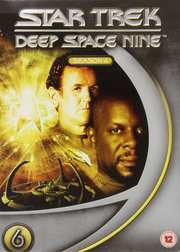
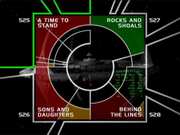
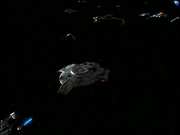
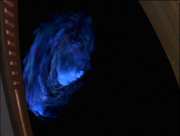
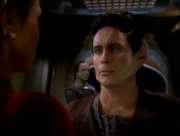
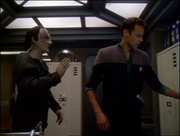
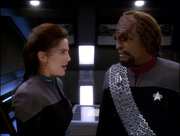
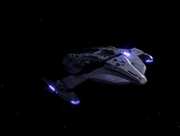

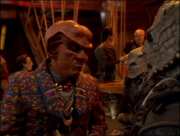
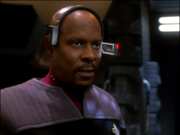
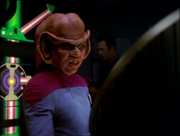
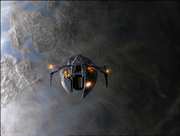
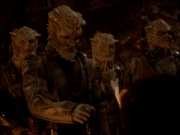
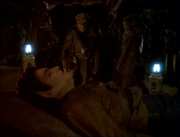
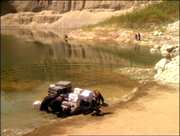
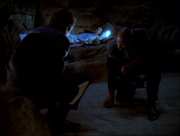
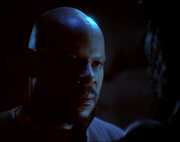
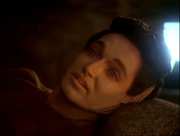
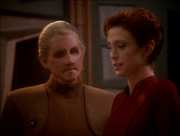
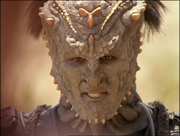

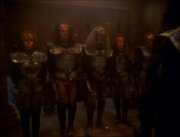
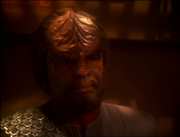
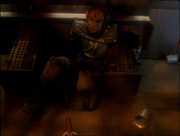
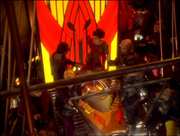
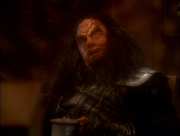
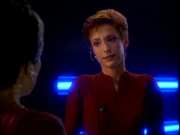

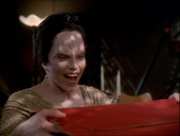
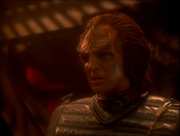
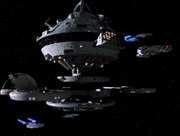
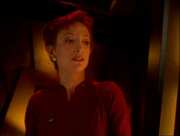

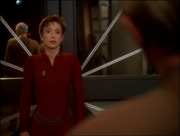
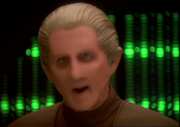


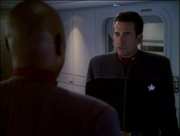
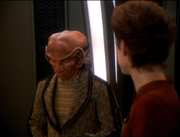
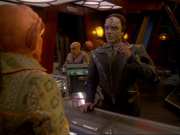






































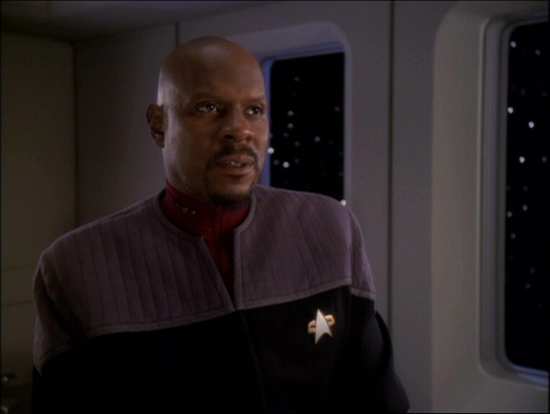












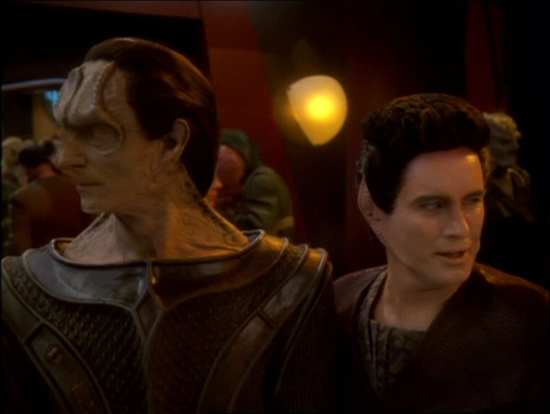

Your Opinions and Comments
Be the first to post a comment!